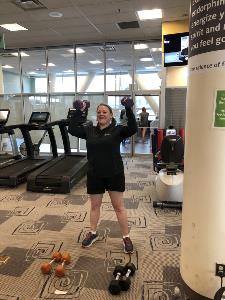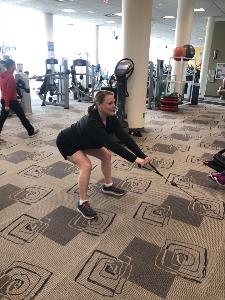by
Erika Slife Hostetler
| Feb 07, 2020
Eileen Bora has to think before she takes a single step, every single day. Both of her ankles are fused together after bone tissue in her ankles died, a result from aggressive cancer treatment.
But she doesn't mind that she needs to think before she walks.
"Just the fact that I can even walk, to me, is miraculous," Eileen said. "As much as I have bad days, I can’t believe I’m alive, and I can’t believe I’m walking."

Eileen, 40, is a survivor of a rare leukemia, mostly found in children. Now six years post chemo treatment, you might find her at Lizzy's Workout of the Week, doing lunges, squats and chest presses, never taking for granted how far she has come.
"Every time I go to the gym, it’s affirming that I’m still healing and that I’m alive," says Eileen, who was a runner up in last year's Biggest Mover Contest.
Getting sick
Eileen was only 31 years old when she got sick. At the time, April of 2011, she was living in Chicago, working in a garden center, pursuing a singing career and training for a triathlon. She had noticed some strange bruises on her body, but chalked it up to anemia, or low blood pressure. She was feeling tired, but blamed it on her grueling work and training schedule.
"Like most things, you ignore it," she said with a laugh. But her boss at Gethsemane Garden Center in Andersonville couldn't ignore it. Eileen recalled her saying,"'You look like a piece of white paper. You have no pink in your skin or lips.'" Her boss made an immediate appointment with her own doctor and got Eileen in right away for blood tests and a chest x-ray.
"The next morning, I got a call at 6:30 from that doctor saying, "OK, I'm going to have you meet me in ER at North Shore," Eileen said. Not knowing how sick she was, she packed only an overnight bag. Her boss drove her to the hospital.
It was then and there that she learned of her diagnosis -- pre-B cell acute lymphoblastic leukemia, a type of blood cancer found commonly in children. It can be fatal if not caught and treated quickly. She underwent an immediate blood and platelet transfusion while the doctor began the conversation with her of long-term treatment options. "If the leukemia doesn't kill you, the treatment could," she said.
Fortunately, Eileen was surrounded by support. Her boss stayed with her while she settled into her room, and her friend stayed with her until her parents arrived from Michigan. She recalled that the care she received from family and friends was "instrumental, supportive and helpful...through all of my healing and recovery."
While she explored best treatment options all over the world, from Michigan to Germany, the doctor suggested she contact the University of Chicago, which was conducting a trial for treatment of young adults with pediatric cancer.
"Turns out that University of Chicago was the best place because they were having this trial," she said. She was admitted the very next day, knowing how very lucky she was that her boss had intervened when she did, and that world-class treatment was only a short drive away.
"Basically I had no oxygen in my blood. Doctors said that if I hadn’t been admitted, I probably would have been dead 24 hours later," she said.
Getting better
But the treatment at the hospital was intense. She stayed hospitalized for about a month and a half, with an aggressive treatment plan that included frequent chemotherapy and transfusions. After she was released in June 2011 -- with no signs of leukemia -- she went into maintenance, which would continue for another 2-and-a-half years.
"The first year was still really aggressive, five days of infusion chemo treatments with daily pills, and a ton of blood transfusions," she said. Her parents, Deirdre and Janusz, moved to Chicago from Michigan, to help her with her new normal.
"Their sacrifice of time, money and energy is immeasurable," she said.
In early 2012, she discovered that she'd developed avascular necrosis -- the death of bone tissue from lack of blood supply -- in her hips, shoulders and ankles, the result from her cancer treatment.
In September 2012, she had her left hip replaced. In December of that year, she had her right shoulder replaced. Six months later, the summer of 2013, she had her left shoulder replaced. Then in September of 2014, she had her right hip replaced. In 2015, and 2016, she had each of her ankles fused.
"I was in physical therapy for years and years," she said. And then as if her health battles weren't enough, Eileen and her family received the devastating news that her mother had ovarian cancer. Deirdre was in treatment for 3 and a half years before dying at the age of 65. During that time, Eileen had been able to move back to Michigan for the last couple of months of her mother's life to help care for her parents in the way that they helped her.
"It was very cathartic to be able to take care of my parents when they needed me most as they had done for me," she said. "It helped wash away some of the sting of survivors' guilt I had as well. We do what we can for the ones that we love and, in some cases, it feels like they moved mountains. I have always been close with my family, but never more so than when we were all trudging through the muck that began in 2011."
Finding a new normal
After she returned back to Chicago, Eileen tried to regain the life she once had. Professionally, she resumed her roles at the Chicago Symphony Chorus, and as a private music instructor and faculty member at the Des Plaines School of Music. In the summer, she also works as a freelance landscaper and teaches gardening curriculum to people across city.
But once cleared to return to the gym, she began her quest to regain strength and mobility. She found Galter about three years ago, based off the recommendation of a friend. Once she learned that it was a certified Medical Fitness Facility, she knew she had found her gym home.

"Galter, to me, symbolizes my continued strength and mobility," she said. "It’s a positive place, it’s a positive, supportive environment. You don’t have to be a championship weight lifter. It’s for normal people, who want to be stronger and healthier."
She says she jumped into her membership, with fluidity barre with Shannon, and AAE (Arthritis Aquatic Exercise) with Erin. She loved Group Groove and Group Fight, but backed off when she realized she was stressing her body out with the high cardio exercises. Instead, she settled into a good routine with Lizzy's Tuesday and Friday Workout of the Weeks.
"I usually try to get (to Galter) between 4 and 6 days a week," she said, where she sees so "many friends, and the staff is all so wonderful and encouraging."
In 2019, she came in as a second place runner up out of 150 participants in Galter's Biggest Mover contest, where one of the challenges was to, indeed, finish a triathlon.
"It felt really redemptive," she said. "I finally got to do it!"
She has met other cancer survivors, and finds inspiration in seeing the patients of cardiac rehab workout. "For me, maintaining a positive attitude, being kind, and feeling grateful for something each day, even if it is as simple as, 'I woke up today!' has kept me healthy emotionally, as well as physically," she says.
She said she joined Galter to "work on my mobility, strength, balance, and get my body moving, I didn’t feel strong, I didn’t feel like myself. That’s when I came to Galter."
And that's when she found the final pieces in becoming herself again.
ehostetler@schosp.org